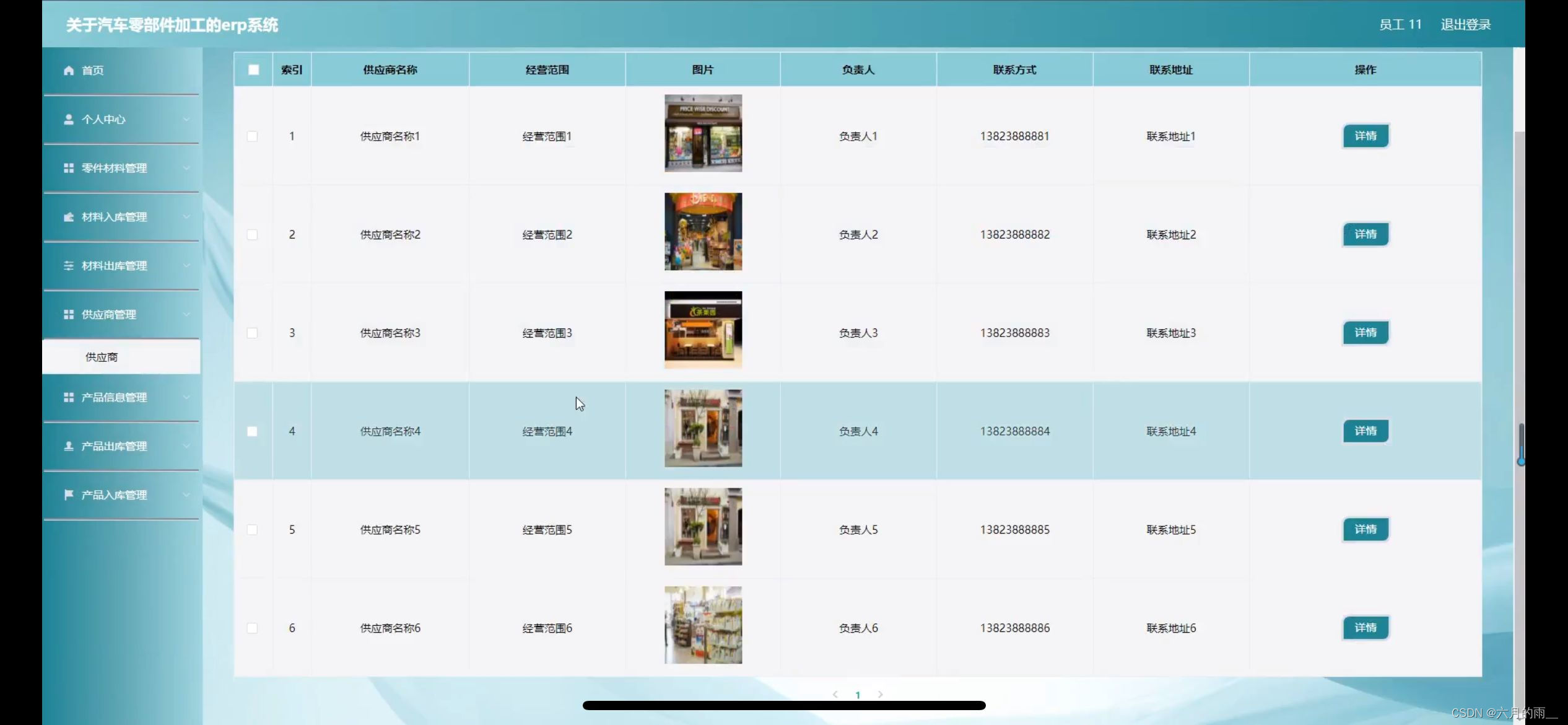作者: Filippos Tzimopoulos
翻译整理:进击的小学生
文章名称: I compared 6 methods to identify the trend of the stock market. These are the results!
code 与 datas ,请转至获取!
背景说明
通过识别市场方向,交易者可以就进入和退出点做出明智的决策,改进整体策略并避免在波动条件下出现代价高昂的错误。
在本文中,您可以期待以下内容:
- 描述最常用的技术分析方法,使用指标来识别趋势;主要指标有:MA(快速、慢速移动平均值)、MACD、RSI、布林带、ADX、Ichimoku Cloud。
- 对于每种方法,使用趋势作为信号,并计算相关绩效指标,主要有:总收益、最大回撤、Sharp、权益曲线;
- 比较不同方法的各种统计数据;
- 根据回测数据绘制趋势图;
在原文基础上为更好理解,做以下调整:
- 作者使用SPY作为标的,考虑更加贴近自身环境,便于理解和对比,标的该为ETF 516510.SH。
- 向上趋势:green 改为 red;向下趋势:red 改为 green
运行环境
Author: lleasy
Python implementation: CPython
Python version : 3.10.9
IPython version : 8.10.0
numpy : 1.26.4
pandas : 2.2.1
matplotlib: 3.8.4
pandas_ta : 0.3.14b0
Compiler : Clang 14.0.6
OS : Darwin
Release : 22.6.0
Machine : x86_64
Processor : i386
CPU cores : 16
Architecture: 64bit
指标介绍
权益曲线(Equity Curve)和净值曲线(Net Value Curve)
权益曲线(Equity Curve)和净值曲线(Net Value Curve)通常用于描述投资组合或基金的价值随时间的变化,但它们在计算和表示上有一些区别:
-
权益曲线(Equity Curve):
- 权益曲线通常从100开始(或者从投资的初始资金开始)。
- 它反映了投资组合的累积价值,考虑到了所有的收益和损失。
- 权益曲线的每个点是通过将起始价值乘以(1加上累积的回报率)来计算的。
- 它通常用于展示交易策略的表现,特别是在量化交易和对冲基金中。
-
净值曲线(Net Value Curve):
- 净值曲线通常从1开始(或者从投资的初始资金除以初始资金额来归一化)。
- 它也反映了投资组合的累积价值,但通常用于基金净值的计算。
- 净值曲线的每个点是通过将起始价值乘以(1加上累积的回报率)并考虑了资金的流入和流出(如投资者的申购和赎回)来计算的。
- 它常用于衡量共同基金或投资基金的表现。
计算方法的区别
-
权益曲线的计算方法通常是:
Equity t = Equity t − 1 × ( 1 + R t ) \text{Equity}_{t} = \text{Equity}_{t-1} \times (1 + R_t) Equityt=Equityt−1×(1+Rt)
其中, E q u i t y t {Equity}_{t} Equityt 是第 $ t $ 天的权益,$ R_t $ 是第 $ t $ 天的回报率。 -
净值曲线的计算方法通常是:
Net Value t = Net Value t − 1 × ( 1 + R t ) × ( 1 + Cash Flow t ) \text{Net Value}_{t} = \text{Net Value}_{t-1} \times (1 + R_t) \times (1 + \text{Cash Flow}_{t}) Net Valuet=Net Valuet−1×(1+Rt)×(1+Cash Flowt)
其中, Net Value t \text{Net Value}_{t} Net Valuet 是第 t t t 天的净值, Cash Flow t \text{Cash Flow}_{t} Cash Flowt 是第 t t t 天的资金流入流出比例。
应用场景的区别
- 权益曲线更多地用于个人投资者或交易者,以及那些关注交易策略表现的场景。
- 净值曲线则更多地用于基金经理和基金公司,以及那些需要向投资者报告基金表现的场景。
总的来说,两者都是衡量投资表现的工具,但权益曲线更侧重于策略的累积表现,而净值曲线则更侧重于基金的整体表现,包括了资金的流入流出。
一目均衡图(Ichimoku Cloud)
一目均衡图又称云图指标、日平均图(Ichimoku Cloud)是一种技术分析方法,它将多个指标组合在一张图表中。它在烛台图表上作为一种交易工具,为交易者提供有关潜在支撑位和阻力位区域的参考。它也被用作预测工具,帮助交易者确定未来趋势和市场动力。
Ichimoku Cloud系统根据高低价格指标显示数据,图表由五组参数组成:
- 转换线(Tenkan-sen):以9日为移动平均线。
- 基线(Kijun-sen):以26日为移动平均线。
- 先行带A(Senkou Span A):通过转换线和基线的移动平均值预计未来26日内趋势
- 先行带B(Senkou Span B):通过52日移动平均值预计未来26日内趋势。
- 迟行带(Chikou Span):今日收盘价与过去26日中线的差值。
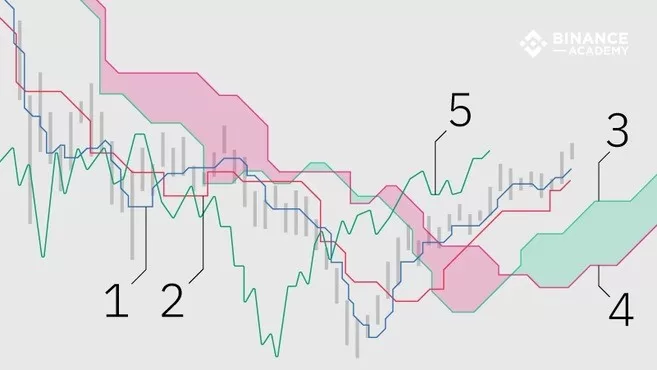
先行带A(3)和先行带B(4)之间的空间称为云带(Kumo),该参数是Ichimoku系统中最值得注意的元素。两条先行带能够预计26日内的市场趋势,因此被视为先行指标。另一方面,迟行带(5)是一个滞后指标,体现了过去26日的趋势。
默认情况下,为方便阅读云带以绿色或红色显示。当先行带A(绿色云线)高于先行带B(红色云线)时,会产生绿色云带。同理,完全相反的情况下会产生红色云带。
一目均衡图(Ichimoku Cloud)详解
# Download the stock data
ticker = '516510.SH'
#df = yf.download(ticker, start='2023-01-01', end='2024-06-01')
df = pd.read_csv('./datas/516510.SH.csv',parse_dates=['datetime'])
df = df[['ts_code','datetime','open','high','low','close','vol']]
df = df.set_index('datetime')
df = df.query('datetime<=20230101').copy()
def calculate_returns(df_for_returns, col_for_returns = 'close', col_for_signal = 'Trend'):
stats = {}
# Calculate daily returns
df_for_returns['Daily_Returns'] = df[col_for_returns].pct_change()
df_for_returns['Returns'] = df_for_returns['Daily_Returns'] * df_for_returns[col_for_signal].shift(1)
df_for_returns['Returns'] = df_for_returns['Returns'].fillna(0)
# 股票或投资组合的权益曲线(Equity Curve)是投资领域中用来展示投资组合价值随时间变化的图表,通常用来评估投资策略的表现。
df_for_returns['Equity Curve'] = 100 * (1 + df_for_returns['Returns']).cumprod()
equity_curve = df_for_returns['Equity Curve']
# Calculate the running maximum of the equity curve
cumulative_max = equity_curve.cummax()
drawdown = (equity_curve - cumulative_max) / cumulative_max
stats['max_drawdown'] = drawdown.min()
# calculate the sharpe ratio
stats['sharpe_ratio'] = (df_for_returns['Returns'].mean() / df_for_returns['Returns'].std()) * np.sqrt(252)
# calculate the total return
stats['total_return'] = (equity_curve.iloc[-1] / equity_curve.iloc[0]) - 1
# calculate the number of long signals
stats['number_of_long_signals'] = len(df_for_returns[df_for_returns[col_for_signal] == 1])
# calculate the number of short signals
stats['number_of_short_signals'] = len(df_for_returns[df_for_returns[col_for_signal] == -1])
return df_for_returns['Equity Curve'], stats
策略回测
快速 + 慢速 移动平均线MA
2 个移动平均线。当快速值高于慢值时,表明呈上升趋势。
def calculate_trend_2_ma(df_ohlc, period_slow=21, period_fast=9):
# Calculate Moving Averages (fast and slow) using pandas_ta
df_ohlc['MA_Fast'] = df_ohlc.ta.sma(close='Close', length=period_fast)
df_ohlc['MA_Slow'] = df_ohlc.ta.sma(close='Close', length=period_slow)
# Determine the trend based on Moving Averages
def identify_trend(row):
if row['MA_Fast'] > row['MA_Slow']:
return 1
elif row['MA_Fast'] < row['MA_Slow']:
return -1
else:
return 0
df_ohlc = df_ohlc.assign(Trend=df_ohlc.apply(identify_trend, axis=1))
df_ohlc['Trend'] = df_ohlc['Trend'].fillna('0')
return df_ohlc['Trend']
df['Trend'] = calculate_trend_2_ma(df, period_slow=21, period_fast=9)
df['Equity Curve'], stats = calculate_returns(df, col_for_returns = 'close', col_for_signal = 'Trend')
# Plotting with adjusted subplot heights
fig, ax1 = plt.subplots(1, 1, figsize=(14, 7), sharex=True)
# Plotting the close price with the color corresponding to the trend
# 当快速值高于慢值时,表明呈上升趋势。
for i in range(1, len(df)):
ax1.plot(df.index[i-1:i+1]
, df['close'].iloc[i-1:i+1]
#, color='red' if df['Trend'].iloc[i] == 1 else ('green' if df['Trend'].iloc[i] == -1 else 'darkgrey')
, color='green' if df['Trend'].iloc[i] == 1 else ('red' if df['Trend'].iloc[i] == -1 else 'darkgrey')
, linewidth=2)
# Plot the Moving Averages
ax1.plot(df['MA_Fast'], label='9-day MA (Fast)', color='blue')
ax1.plot(df['MA_Slow'], label='21-day MA (Slow)', color='orange')
ax1.set_title(f'{ticker} - Price and Moving Averages')
ax1.text(0.5, 0.9, f"Total Return: {stats['total_return']:.2%}", transform=ax1.transAxes, ha='center', va='top', fontsize=14)
ax1.legend(loc='best')
plt.show()
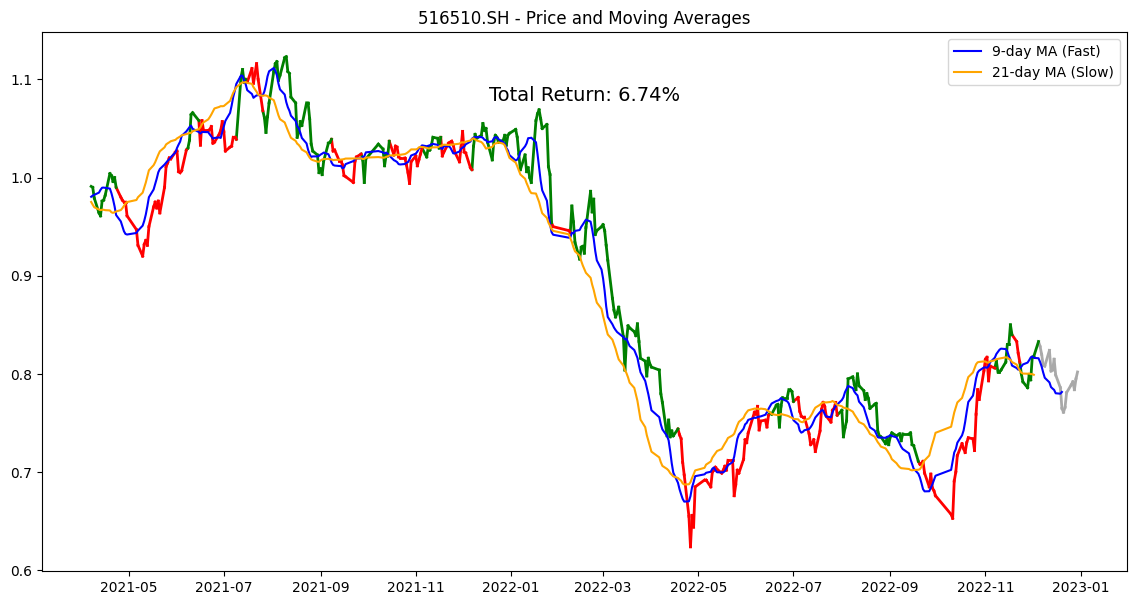
MA + MACD
上升趋势,收盘价应高于移动平均线,MACD 线应高于 MACD 信号。
def calculate_trend_macd_ma(df_ohlc, ma_period=50, macd_fast=12, macd_slow=26, macd_signal=9):
# Calculate MACD using pandas_ta
df_ohlc.ta.macd(close='close', fast=macd_fast, slow=macd_slow, signal=macd_signal, append=True)
# Calculate Moving Average
df_ohlc['MA'] = df_ohlc.ta.sma(close='close', length=ma_period)
# Determine the trend based on MA and MACD
def identify_trend(row):
macd_name = f'{macd_fast}_{macd_slow}_{macd_signal}'
# 收盘价应高于移动平均线,MACD 线应高于 MACD 信号。
if row['close'] > row['MA'] and row[f'MACD_{macd_name}'] > row[f'MACDs_{macd_name}']:
return 1
elif row['close'] < row['MA'] and row[f'MACD_{macd_name}'] < row[f'MACDs_{macd_name}']:
return -1
else:
return 0
df_ohlc['Trend'] = df_ohlc.apply(identify_trend, axis=1)
return df_ohlc['Trend']
df['Trend'] = calculate_trend_macd_ma(df, ma_period=50, macd_fast=12, macd_slow=26, macd_signal=9)
df['Equity Curve'], stats = calculate_returns(df, col_for_returns = 'close', col_for_signal = 'Trend')
# Plotting with adjusted subplot heights
fig, (ax1, ax2) = plt.subplots(2, 1, figsize=(14, 10), sharex=True,
gridspec_kw={'height_ratios': [3, 1]})
# Plotting the close price with the color corresponding to the trend
for i in range(1, len(df)):
ax1.plot(df.index[i-1:i+1]
, df['close'].iloc[i-1:i+1]
, color='red' if df['Trend'].iloc[i] == 1 else ('green' if df['Trend'].iloc[i] == -1 else 'darkgrey')
, linewidth=2)
# Plot the Moving Average
ax1.plot(df['MA'], label=f'50-day MA', color='orange')
ax1.set_title(f'{ticker} - Price and Moving Average')
ax1.text(0.5, 0.9, f"Total Return: {stats['total_return']:.2%}", transform=ax1.transAxes, ha='center', va='top', fontsize=14)
ax1.legend(loc='best')
# Plot MACD and Signal Line on the second subplot (smaller height)
ax2.plot(df.index, df['MACD_12_26_9'], label='MACD', color='blue')
ax2.plot(df.index, df['MACDs_12_26_9'], label='Signal Line', color='red')
ax2.set_title(f'{ticker} - MACD')
ax2.legend(loc='best')
plt.show()
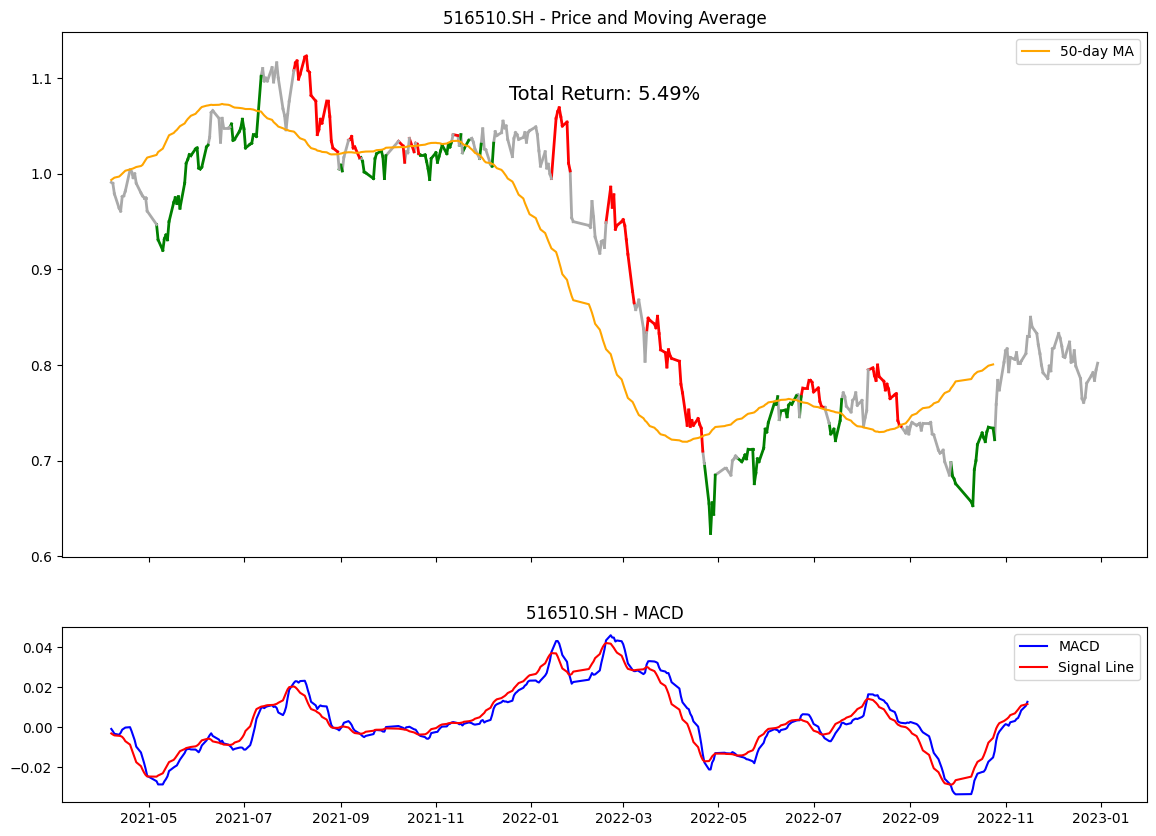
RSI + 快速和慢速移动平均线
快速 MA 应高于慢速 MA,RSI > 50 以确定上升趋势和下降趋势的相反趋势。
def calculate_trend_rsi_ma(df_ohlc, rsi_period=14, ma_fast=9, ma_slow=21):
# Calculate RSI using pandas_ta
df_ohlc['RSI'] = df.ta.rsi(close='close', length=rsi_period)
# Calculate Moving Averages (14-day and 50-day) using pandas_ta
df_ohlc[f'MA_{ma_fast}'] = df_ohlc.ta.sma(close='close', length=14)
df_ohlc[f'MA_{ma_slow}'] = df_ohlc.ta.sma(close='close', length=50)
# Determine the trend based on RSI and Moving Averages
# 快速 MA 应高于慢速 MA,RSI > 50 以确定上升趋势
def identify_trend(row):
if row['RSI'] > 50 and row[f'MA_{ma_fast}'] > row[f'MA_{ma_slow}']:
return 1
elif row['RSI'] < 50 and row[f'MA_{ma_fast}'] < row[f'MA_{ma_slow}']:
return -1
else:
return 0
df_ohlc['Trend'] = df_ohlc.apply(identify_trend, axis=1)
return df_ohlc['Trend']
df['Trend'] = calculate_trend_rsi_ma(df, rsi_period=14, ma_fast=14, ma_slow=50)
df['Equity Curve'], stats = calculate_returns(df, col_for_returns = 'close', col_for_signal = 'Trend')
# Plotting with adjusted subplot heights
fig, (ax1, ax2) = plt.subplots(2, 1, figsize=(14, 10), sharex=True,
gridspec_kw={'height_ratios': [3, 1]})
# Plotting the close price with the color corresponding to the trend
for i in range(1, len(df)):
ax1.plot(df.index[i-1:i+1]
, df['close'].iloc[i-1:i+1]
, color='red' if df['Trend'].iloc[i] == 1 else ('green' if df['Trend'].iloc[i] == -1 else 'darkgrey')
, linewidth=2)
# Plot the Moving Averages
ax1.plot(df['MA_14'], label='14-day MA', color='blue')
ax1.plot(df['MA_50'], label='50-day MA', color='orange')
ax1.text(0.5, 0.9, f"Total Return: {stats['total_return']:.2%}", transform=ax1.transAxes, ha='center', va='top', fontsize=14)
ax1.set_title(f'{ticker} - Price, RSI and Fast and Slow Moving Average')
ax1.legend(loc='best')
# Plot RSI on the second subplot (smaller height)
ax2.plot(df.index, df['RSI'], label='RSI', color='purple')
ax2.axhline(50, color='black', linestyle='--', linewidth=1) # Add a horizontal line at RSI=50
ax2.set_title(f'{ticker} - RSI')
ax2.legend(loc='best')
plt.show()
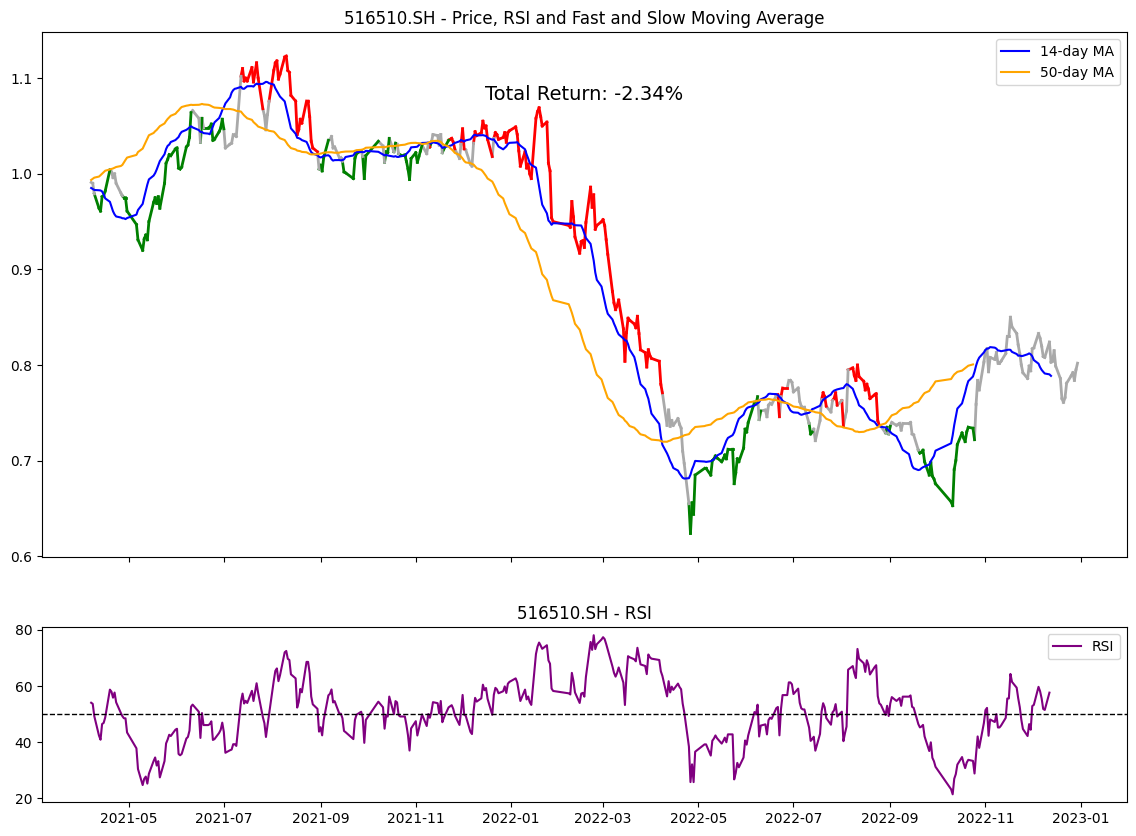
RSI + 布林带
当价格高于中间布林带且 RSI 高于 50 时,我们有一个上升趋势。
def calculate_trend_bbands_rsi(df_ohlc, bbands_period=5, bbands_std=2, rsi_period=14):
# Calculate RSI using pandas_ta
df_ohlc['RSI'] = df_ohlc.ta.rsi(close='close', length=rsi_period)
# Calculate Bollinger Bands using pandas_ta
bbands = df.ta.bbands(close='close', length=bbands_period, std=bbands_std)
df_ohlc['BB_upper'] = bbands[f'BBU_{bbands_period}_{bbands_std}.0']
df_ohlc['BB_middle'] = bbands[f'BBM_{bbands_period}_{bbands_std}.0']
df_ohlc['BB_lower'] = bbands[f'BBL_{bbands_period}_{bbands_std}.0']
# Determine the trend based on Bollinger Bands and RSI
# 当价格高于中间布林带且 RSI 高于 50 时,上升趋势。
def identify_trend(row):
if row['close'] > row['BB_middle'] and row['RSI'] > 50:
return 1
elif row['close'] < row['BB_middle'] and row['RSI'] < 50:
return -1
else:
return 0
df_ohlc['Trend'] = df_ohlc.apply(identify_trend, axis=1)
return df_ohlc['Trend']
df['Trend'] = calculate_trend_bbands_rsi(df, bbands_period=20, bbands_std=2, rsi_period=14)
df['Equity Curve'], stats = calculate_returns(df, col_for_returns = 'close', col_for_signal = 'Trend')
# Plotting with adjusted subplot heights
fig, (ax1, ax2) = plt.subplots(2, 1, figsize=(14, 10), sharex=True,
gridspec_kw={'height_ratios': [3, 1]})
# Plotting the close price with the color corresponding to the trend
for i in range(1, len(df)):
ax1.plot(df.index[i-1:i+1]
, df['close'].iloc[i-1:i+1]
, color='red' if df['Trend'].iloc[i] == 1 else ('green' if df['Trend'].iloc[i] == -1 else 'darkgrey')
, linewidth=2)
# Plot Bollinger Bands
ax1.plot(df['BB_upper'], label='Upper Band', color='blue', linestyle='--')
ax1.plot(df['BB_middle'], label='Middle Band', color='orange')
ax1.plot(df['BB_lower'], label='Lower Band', color='blue', linestyle='--')
ax1.text(0.5, 0.9, f"Total Return: {stats['total_return']:.2%}", transform=ax1.transAxes, ha='center', va='top', fontsize=14)
ax1.set_title(f'{ticker} - Price, RSI and Bollinger Bands')
ax1.legend(loc='best')
# Plot RSI on the second subplot (smaller height)
ax2.plot(df.index, df['RSI'], label='RSI', color='purple')
ax2.axhline(50, color='black', linestyle='--', linewidth=1) # Add a horizontal line at RSI=50
ax2.set_title(f'{ticker} - RSI')
ax2.legend(loc='best')
plt.show()

ADX + 慢速和快速移动平均线
通过结合 ADX 和移动平均线,当 ADX 高于 25(表明强劲趋势)且快速 MA 高于慢速 MA 时,我们将确定上升趋势。
def calculate_trend_adx_ma(df_ohlc, adx_period=14, fast_ma_period=14, slow_ma_period=50):
# Calculate ADX using pandas_ta
df_ohlc['ADX'] = df_ohlc.ta.adx(length=adx_period)[f'ADX_{adx_period}']
# Calculate Moving Averages (14-day and 50-day) using pandas_ta
df_ohlc['MA_fast'] = df_ohlc.ta.sma(close='close', length=fast_ma_period)
df_ohlc['MA_slow'] = df_ohlc.ta.sma(close='close', length=slow_ma_period)
# Determine the trend based on ADX and Moving Averages
# 当 ADX 高于 25(表明强劲趋势)且快速 MA 高于慢速 MA 时,上升趋势
def identify_trend(row):
if row['ADX'] > 25 and row['MA_fast'] > row['MA_slow']:
return 1
elif row['ADX'] > 25 and row['MA_fast'] < row['MA_slow']:
return -1
else:
return 0
df_ohlc['Trend'] = df_ohlc.apply(identify_trend, axis=1)
return df_ohlc['Trend']
df['Trend'] = calculate_trend_adx_ma(df, adx_period=14, fast_ma_period=14, slow_ma_period=50)
df['Equity Curve'], stats = calculate_returns(df, col_for_returns = 'close', col_for_signal = 'Trend')
# Plotting with adjusted subplot heights
fig, (ax1, ax2) = plt.subplots(2, 1, figsize=(14, 10), sharex=True,
gridspec_kw={'height_ratios': [3, 1]})
# Plotting the close price with the color corresponding to the trend
for i in range(1, len(df)):
ax1.plot(df.index[i-1:i+1]
, df['close'].iloc[i-1:i+1]
, color='red' if df['Trend'].iloc[i] == 1 else ('green' if df['Trend'].iloc[i] == -1 else 'darkgrey')
, linewidth=2)
# Plot the Moving Averages
ax1.plot(df['MA_fast'], label='Fast MA', color='blue')
ax1.plot(df['MA_slow'], label='Slow MA', color='orange')
ax1.text(0.5, 0.9, f"Total Return: {stats['total_return']:.2%}", transform=ax1.transAxes, ha='center', va='top', fontsize=14)
ax1.set_title(f'{ticker} - Price, ADX and Moving Averages')
ax1.legend(loc='best')
# Plot ADX on the second subplot (smaller height)
ax2.plot(df.index, df['ADX'], label='ADX', color='purple')
ax2.axhline(25, color='black', linestyle='--', linewidth=1) # Add a horizontal line at ADX=25
ax2.set_title(f'{ticker} - ADX')
ax2.legend(loc='best')
plt.show()
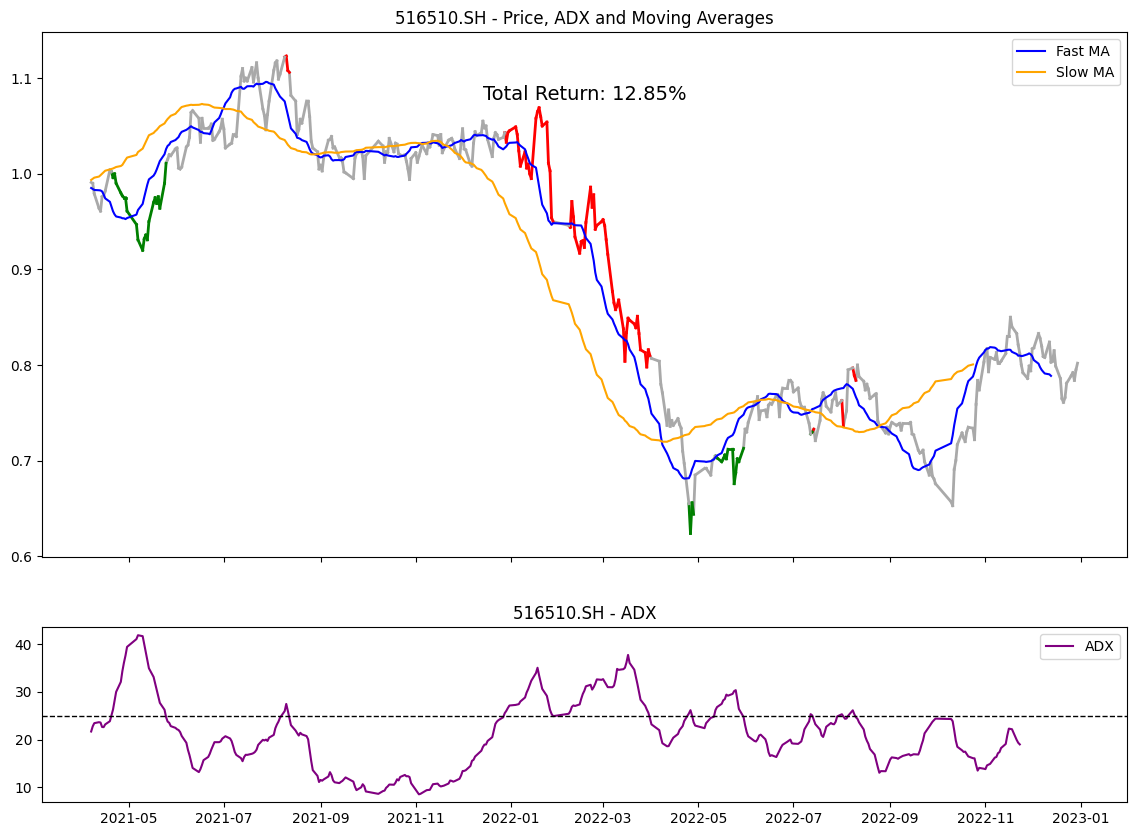
Ichimoku Cloud + MACD
当价格高于 Ichimoku Cloud 且 MACD 高于信号线时,我们确定上升趋势。
def calculate_trend_ichimoku_macd(df_ohlc, macd_fast=12, macd_slow=26, macd_signal=9, tenkan=9, kijun=26, senkou=52):
# Calculate Ichimoku Cloud components using pandas_ta
df_ichimoku = df_ohlc.ta.ichimoku(tenkan, kijun, senkou)[0]
# Extract Ichimoku Cloud components
df_ohlc['Ichimoku_Conversion'] = df_ichimoku[f'ITS_{tenkan}'] # Tenkan-sen (Conversion Line)
df_ohlc['Ichimoku_Base'] = df_ichimoku[f'IKS_{kijun}'] # Kijun-sen (Base Line)
df_ohlc['Ichimoku_Span_A'] = df_ichimoku[f'ITS_{tenkan}'] # Senkou Span A
df_ohlc['Ichimoku_Span_B'] = df_ichimoku[f'ISB_{kijun}'] # Senkou Span B
# Calculate MACD using pandas_ta
df_ohlc.ta.macd(close='close', fast=macd_fast, slow=macd_slow, signal=macd_signal, append=True)
# Determine the trend based on Ichimoku Cloud and MACD
# 当价格高于 Ichimoku Cloud 且 MACD 高于信号线时,我们确定上升趋势。
def identify_trend(row):
if row['close'] > max(row['Ichimoku_Span_A'], row['Ichimoku_Span_B']) and row['MACD_12_26_9'] > row['MACDs_12_26_9']:
return 1
elif row['close'] < min(row['Ichimoku_Span_A'], row['Ichimoku_Span_B']) and row['MACD_12_26_9'] < row['MACDs_12_26_9']:
return -1
else:
return 0
df_ohlc['Trend'] = df_ohlc.apply(identify_trend, axis=1)
return df_ohlc['Trend']
df['Trend'] = calculate_trend_ichimoku_macd(df, macd_fast=12, macd_slow=26, macd_signal=9)
df['Equity Curve'], stats = calculate_returns(df, col_for_returns = 'close', col_for_signal = 'Trend')
# Plotting with adjusted subplot heights
fig, (ax1, ax2) = plt.subplots(2, 1, figsize=(14, 10), sharex=True,
gridspec_kw={'height_ratios': [3, 1]})
# Plotting the close price with the color corresponding to the trend
for i in range(1, len(df)):
ax1.plot(df.index[i-1:i+1]
, df['close'].iloc[i-1:i+1]
, color='red' if df['Trend'].iloc[i] == 1 else ('green' if df['Trend'].iloc[i] == -1 else 'darkgrey')
, linewidth=2)
# Plot Ichimoku Cloud
ax1.fill_between(df.index, df['Ichimoku_Span_A'], df['Ichimoku_Span_B'],
where=(df['Ichimoku_Span_A'] >= df['Ichimoku_Span_B']), color='lightgreen', alpha=0.5)
ax1.fill_between(df.index, df['Ichimoku_Span_A'], df['Ichimoku_Span_B'],
where=(df['Ichimoku_Span_A'] < df['Ichimoku_Span_B']), color='lightcoral', alpha=0.5)
ax1.plot(df['Ichimoku_Conversion'], label='Conversion Line (Tenkan-sen)', color='blue')
ax1.plot(df['Ichimoku_Base'], label='Base Line (Kijun-sen)', color='orange')
ax1.text(0.5, 0.9, f"Total Return: {stats['total_return']:.2%}", transform=ax1.transAxes, ha='center', va='top', fontsize=14)
ax1.set_title(f'{ticker} - Price and Ichimoku Cloud')
ax1.legend(loc='best')
# Plot MACD and Signal Line on the second subplot (smaller height)
ax2.plot(df.index, df['MACD_12_26_9'], label='MACD', color='blue')
ax2.plot(df.index, df['MACDs_12_26_9'], label='Signal Line', color='red')
ax2.set_title(f'{ticker} - MACD')
ax2.legend(loc='best')
plt.show()
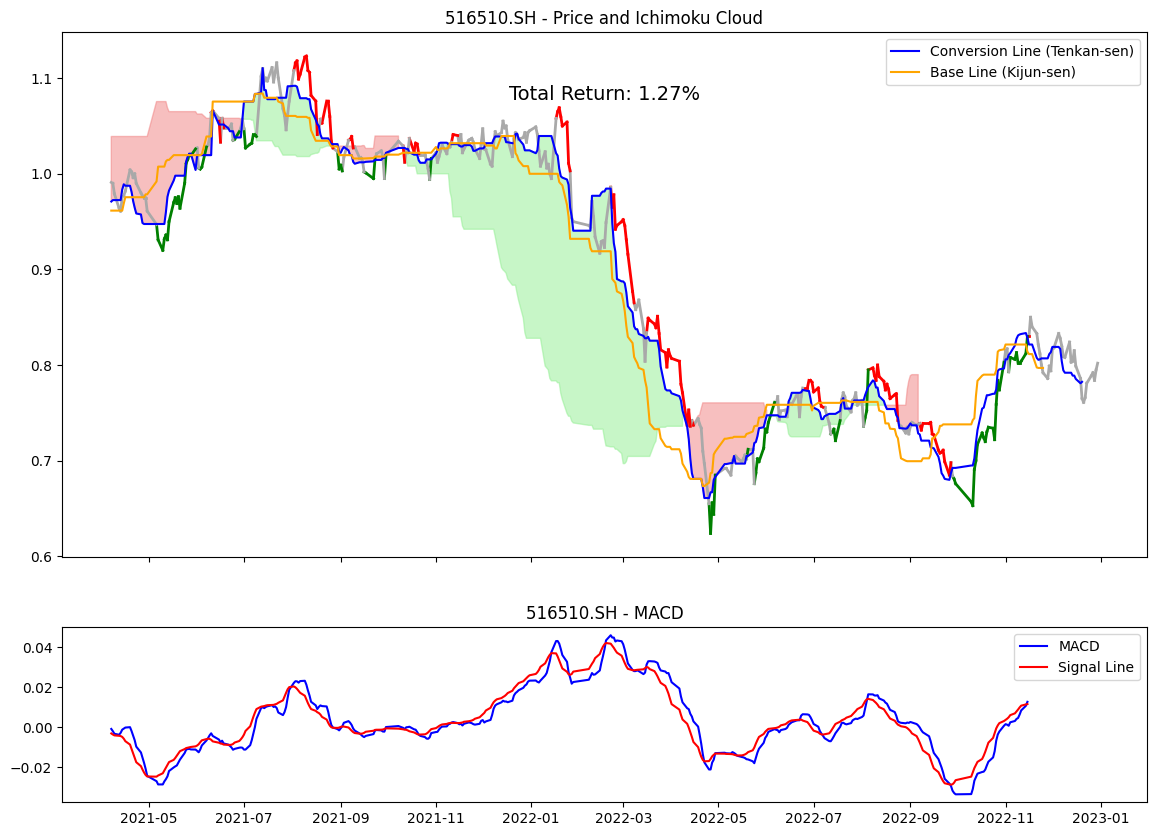
结果总结
最后,对以上两两组合指标回测结果进行汇总比较:
# Download the stock data
#ticker = 'SPY' # You can replace 'AAPL' with any other stock ticker or currency pair
#df = yf.download(ticker, start='2023-01-01', end='2024-06-01')
trend_identification_methods = ['2_ma', 'macd_ma', 'rsi_ma', 'bbands_rsi', 'adx_ma', 'ichimoku_macd']
trend_identification_results = []
def calculate_trend(df, method):
if method == '2_ma':
return calculate_trend_2_ma(df, period_slow=21, period_fast=9)
elif method == 'macd_ma':
return calculate_trend_macd_ma(df, ma_period=50, macd_fast=12, macd_slow=26, macd_signal=9)
elif method == 'rsi_ma':
return calculate_trend_rsi_ma(df, rsi_period=14, ma_fast=9, ma_slow=21)
elif method == 'bbands_rsi':
return calculate_trend_bbands_rsi(df, bbands_period=5, bbands_std=2, rsi_period=14)
elif method == 'adx_ma':
return calculate_trend_adx_ma(df, adx_period=14, fast_ma_period=14, slow_ma_period=50)
elif method == 'ichimoku_macd':
return calculate_trend_ichimoku_macd(df, macd_fast=12, macd_slow=26, macd_signal=9, tenkan=9, kijun=26, senkou=52)
for method in trend_identification_methods:
# Calculate results of returns for each method and append to the list
df_copy = df.copy()
d = {}
d['Method'] = method
df_copy['Trend'] = calculate_trend(df_copy, method)
df_copy['Equity Curve'], stats = calculate_returns(df_copy, col_for_returns = 'close', col_for_signal = 'Trend')
d.update(stats)
trend_identification_results.append(d)
# Add trend line and equity curve to the df
df[f'Trend_{method}'] = df_copy['Trend']
df[f'Equity Curve_{method}'] = df_copy['Equity Curve']
trend_identification_results_df = pd.DataFrame(trend_identification_results)
trend_identification_results_df
| Method | max_drawdown | sharpe_ratio | total_return | number_of_long_signals | number_of_short_signals | |
|---|---|---|---|---|---|---|
| 0 | 2_ma | -0.220514 | 0.279125 | 0.067435 | 217 | 187 |
| 1 | macd_ma | -0.197766 | 0.258573 | 0.054929 | 100 | 121 |
| 2 | rsi_ma | -0.265611 | 0.049457 | -0.023366 | 141 | 129 |
| 3 | bbands_rsi | -0.302148 | 0.280353 | 0.065393 | 169 | 128 |
| 4 | adx_ma | -0.130235 | 0.531043 | 0.128481 | 67 | 38 |
| 5 | ichimoku_macd | -0.230752 | 0.136560 | 0.012655 | 103 | 82 |
在该标的下,ADX 和 快速和慢速移动平均线的组合下 sharpe 最大 、 max_drawdown 最小,收益率也高于其他组合。
多股票回测
tickers = ['AAPL', 'AMZN', 'GOOG', 'TSLA', 'SPY']
results = []
for ticker in tickers:
df = yf.download(ticker, start='2023-01-01', end='2024-06-01')
trend_identification_methods = ['2_ma', 'macd_ma', 'rsi_ma', 'bbands_rsi', 'adx_ma', 'ichimoku_macd']
trend_identification_results = []
def calculate_trend(df, method):
if method == '2_ma':
return calculate_trend_2_ma(df, period_slow=21, period_fast=9)
elif method == 'macd_ma':
return calculate_trend_macd_ma(df, ma_period=50, macd_fast=12, macd_slow=26, macd_signal=9)
elif method == 'rsi_ma':
return calculate_trend_rsi_ma(df, rsi_period=14, ma_fast=9, ma_slow=21)
elif method == 'bbands_rsi':
return calculate_trend_bbands_rsi(df, bbands_period=5, bbands_std=2, rsi_period=14)
elif method == 'adx_ma':
return calculate_trend_adx_ma(df, adx_period=14, fast_ma_period=14, slow_ma_period=50)
elif method == 'ichimoku_macd':
return calculate_trend_ichimoku_macd(df, macd_fast=12, macd_slow=26, macd_signal=9, tenkan=9, kijun=26, senkou=52)
for method in trend_identification_methods:
# Calculate results of returns for each method and append to the list
df_copy = df.copy()
d = {}
d['Method'] = method
df_copy['Trend'] = calculate_trend(df_copy, method)
df_copy['Equity Curve'], stats = calculate_returns(df_copy, col_for_returns = 'Close', col_for_signal = 'Trend')
results.append({'ticker':ticker, 'method':method, 'total_return':stats['total_return']})
test_df = pd.DataFrame(results)
# Pivot the DataFrame to prepare for plotting
pivot_df = test_df.pivot(index='ticker', columns='method', values='total_return')
# Plotting
pivot_df.plot(kind='bar', figsize=(12, 8))
plt.title('Comparison of total returns per trend method')
plt.ylabel('Value')
plt.xlabel('Stock')
plt.legend(title='Indicators', bbox_to_anchor=(1.05, 1), loc='upper left')
plt.xticks(rotation=45)
plt.tight_layout()
plt.show()



















